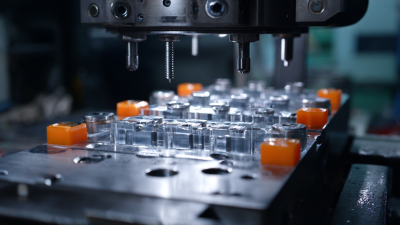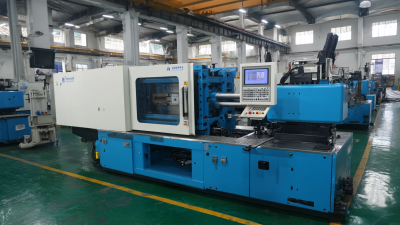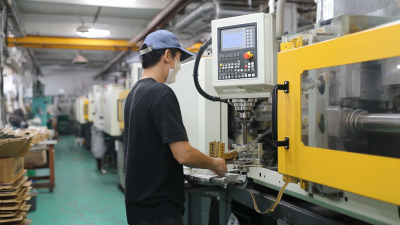How to Enhance Your Plastic Injection Molding Process for Maximum Efficiency
As industries continue to evolve in the face of increasing demand and competition, enhancing operational efficiency has become paramount, especially in the realm of plastic injection molding. This critical manufacturing process not only allows for the mass production of intricate parts but also significantly impacts overall product quality and workflow efficiency. By adopting innovative techniques and technologies, manufacturers can optimize their plastic injection molding processes, leading to reduced cycle times, minimized waste, and improved resource management.

In this blog, we will explore strategic approaches to enhance your plastic injection molding operations, ensuring you remain competitive and responsive to market needs while paving the way for a more sustainable and efficient future. Join us as we delve into best practices, emerging trends, and actionable insights designed to maximize your production capabilities in this dynamic landscape.
Understanding the Key Factors Affecting Plastic Injection Molding Efficiency
When it comes to optimizing plastic injection molding efficiency, understanding the key factors at play is crucial. One of the most significant factors is the design of the mold itself. A well-designed mold not only reduces cycle times but also minimizes defects in the finished product. Features such as venting, cooling channels, and appropriate gating systems can substantially affect the flow of material and cooling times, ultimately impacting productivity.
Another critical aspect is the choice of materials and injection parameters. Selecting the right resin and adjusting the temperature settings can significantly influence the viscosity and flow characteristics of the plastic. For instance, using a resin with lower viscosity can enhance flow rates, while maintaining the correct injection pressure and speed helps ensure uniform part fill and reduces the chances of creating air traps or incomplete fills. By fine-tuning these parameters, manufacturers can enhance both efficiency and product quality, leading to better overall performance in their injection molding processes.
How to Enhance Your Plastic Injection Molding Process for Maximum Efficiency
| Key Factor | Impact on Efficiency | Recommended Practices |
|---|---|---|
| Machine Calibration | Ensures consistent part quality and reduces cycle time | Regular calibration checks and adjustments |
| Material Quality | Directly affects flow characteristics and finished part strength | Use high-grade resins and verify supplier quality |
| Heating Systems | Influences melt viscosity and cycle consistency | Regular maintenance and temperature monitoring |
| Cooling Efficiency | Shortens cycle times and improves defect rates | Optimize cooling channel design and flow rates |
| Operator Training | Enhances skill level and process understanding | Continuous training and assessment programs |
| Automation Levels | Improves speed and reduces human error | Invest in automation tools and smart technologies |
Comparing Traditional vs. Advanced Injection Molding Techniques for Efficiency Gains
In the highly competitive realm of
plastic manufacturing, efficiency is paramount.
Traditional injection molding techniques have long been the industry standard; however,
recent innovations are pushing the boundaries of productivity. For instance, a report by the
Plastics Industry Association
highlights that companies utilizing advanced injection molding technologies can
increase their production rates by up to 25%.
These methods, which include the use of robotics and smart sensors, not only
streamline operations but also enhance accuracy and repeatability in the manufacturing process.
Moreover, the shift towards advanced injection molding techniques can significantly reduce
energy consumption. According to a study conducted by the
Society of Plastics Engineers, the
implementation of advanced thermal controls and optimized cycle times can lead to energy
savings of approximately 30% compared to traditional methods.
This is particularly relevant as manufacturers increasingly prioritize
sustainability. By adopting these cutting-edge
processes, businesses can not only boost their efficiency but also align with
environmental standards that are becoming
essential in today’s market.
Evaluating the Role of Equipment Maintenance in Injection Molding Performance
Effective equipment maintenance is crucial in the plastic injection molding process, significantly impacting overall performance and efficiency. Regularly maintaining machinery not only reduces the likelihood of unexpected breakdowns but also ensures that the injection molding machines operate at their optimal capacity. Scheduled maintenance checks, including cleaning, lubrication, and parts replacement, help preserve the precision and speed of production. Such proactive measures lead to consistent product quality and reduced cycle times, ultimately enhancing productivity.
Furthermore, understanding the specific requirements of your molding equipment is essential for tailored maintenance practices. Each machine may have unique operational characteristics and wear patterns, making it vital to establish a maintenance routine based on manufacturer recommendations and operational data. By implementing predictive maintenance strategies, companies can anticipate potential issues before they affect production, thereby minimizing downtime. Investing in equipment care not only improves the longevity of machines but also enhances the overall efficiency of the injection molding process.
Injection Molding Equipment Maintenance and Efficiency
Analyzing the Impact of Material Selection on Molding Process Efficiency
When it comes to plastic injection molding, the choice of materials can significantly influence the overall efficiency of the process. Different polymers exhibit unique thermal properties, flow characteristics, and cooling times, which can directly affect cycle times and the quality of the final product. For instance, using a thermoplastic material with a lower melt viscosity can facilitate faster injection and reduce clamping force requirements, leading to lesser energy consumption and shorter production cycles.
Moreover, material selection plays a crucial role in minimizing defects during molding. For example, resins that offer better fluidity and thermal stability can help in achieving uniform filling and reducing the risk of issues like warping or incomplete fill. Additionally, incorporating additives or choosing composite materials can enhance the mechanical properties of the molded parts while also allowing for optimized processing parameters. By investing time in evaluating and selecting the right materials to suit specific applications, manufacturers can not only improve the efficiency of their molding processes but also produce high-quality components that meet market demands.

Exploring Automation Solutions for Enhanced Plastic Injection Molding Productivity
Automation has transformed many manufacturing processes, and plastic injection molding is no exception. Integrating automation solutions can significantly enhance productivity and efficiency in the molding process. By incorporating robotics for part handling, manufacturers can minimize cycle times and reduce labor costs. Automated systems can manage tasks such as loading and unloading molds, reducing the risk of human error while ensuring consistent quality throughout production runs.
Moreover, advanced software solutions can optimize the injection molding process. By utilizing real-time monitoring and data analysis, manufacturers can identify bottlenecks and predict maintenance needs before problems arise. This proactive approach not only increases uptime but also enhances the overall quality of the molded products. As companies embrace digital transformation, leveraging automation technology will play a crucial role in staying competitive in the ever-evolving plastic injection molding landscape.

Related Posts
-

Exploring Alternative Methods to Automotive Injection Molding for Efficient Production
-

What Are the Essential Components of Plastic Injection Machine Parts?
-

Top 7 Import Export Certifications for Best Plastic Injection Molding Machines in 2023
-

Unlocking Efficiency: The Advantages of Advanced Plastic Injection Molding Machines for Global Buyers
-

2025 Trends in Overmolding Injection Molding: How to Choose the Best Solutions for Global Sourcing
-

Custom Solutions for Efficient Injection Molding Machine Molds in Global Industries
Submit a quote request or book a design consultation
Plastimold Products is an end-to-end product development and manufacturing team. We provide product design, engineering, prototyping, tooling, plastic injection molding, assembly, packaging and fulfillment. We work with any size company from start-ups to enterprises from all around the world.
I have a product I want to manufacture
I have a product that is already designed and now needs to be manufactured.
I need a manufacturer to optimize my product for injection molding, help choose the correct material, and manage the product production.
I have tooling that I want to transfer or modify, or I need to produce new tooling.
I need design and engineering support
I have a product concept that I want to be designed and brought to market.
I have a product that needs to be reviewed, improved or DFM’ed.
I am looking for a manufacturer to provide an end-to-end solution, from design and development to inventory, marketing, and sales.
©2022 Plastimold Products - Privacy policy - Terms and Conditions

